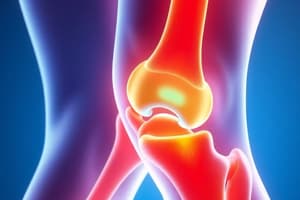Podcast
Questions and Answers
In a joint affected by osteoarthritis, which structure is typically the first to show signs of degeneration?
In a joint affected by osteoarthritis, which structure is typically the first to show signs of degeneration?
- Cartilage (correct)
- Ligament
- Synovial membrane
- Bone
A 60-year-old male with a 30-year history of smoking presents with dyspnea on exertion and a dry cough. A CT scan reveals reticular basilar opacity. What is the most likely diagnosis?
A 60-year-old male with a 30-year history of smoking presents with dyspnea on exertion and a dry cough. A CT scan reveals reticular basilar opacity. What is the most likely diagnosis?
- Chronic obstructive pulmonary disease
- Emphysema
- Chronic bronchitis
- Interstitial lung disease (correct)
For a patient with incomplete T12 paraplegia preparing for ambulation with crutches, which group of upper quadrant muscles is MOST crucial to strengthen?
For a patient with incomplete T12 paraplegia preparing for ambulation with crutches, which group of upper quadrant muscles is MOST crucial to strengthen?
- Upper trapezius, rhomboids, and levator scapulae
- Lower trapezius, latissimus dorsi, and triceps (correct)
- Middle trapezius, latissimus dorsi, and triceps
- Supraspinatus, biceps, and latissimus dorsi
During a physical therapy session, a therapist assesses a one-year-old child with Down syndrome. Which physical characteristic is MOST commonly observed in this population?
During a physical therapy session, a therapist assesses a one-year-old child with Down syndrome. Which physical characteristic is MOST commonly observed in this population?
A patient who underwent meniscal repair surgery asks when they can start walking. What is the EARLIEST time after surgery that a patient can begin weight bearing?
A patient who underwent meniscal repair surgery asks when they can start walking. What is the EARLIEST time after surgery that a patient can begin weight bearing?
What is the PRIMARY function of a Kegel perineometer in the management of stress urinary incontinence?
What is the PRIMARY function of a Kegel perineometer in the management of stress urinary incontinence?
An older adult is 2 days post cemented total hip replacement (THR). What should be the physical therapy plan of care's INITIAL priority?
An older adult is 2 days post cemented total hip replacement (THR). What should be the physical therapy plan of care's INITIAL priority?
A 60-year-old male with a 30-year smoking history presents with dyspnea on exertion, a dry cough, and reticular basilar opacity on a CT scan. If arterial blood gases reveal hypoxemia, which mode of non-invasive ventilation is MOST appropriate?
A 60-year-old male with a 30-year smoking history presents with dyspnea on exertion, a dry cough, and reticular basilar opacity on a CT scan. If arterial blood gases reveal hypoxemia, which mode of non-invasive ventilation is MOST appropriate?
Abdominal surgeries are broadly classified by location. Which of the following is considered a lower abdominal surgery?
Abdominal surgeries are broadly classified by location. Which of the following is considered a lower abdominal surgery?
Which treatment technique uses fine wire or needle electrodes to objectively record muscle activity?
Which treatment technique uses fine wire or needle electrodes to objectively record muscle activity?
A two-year-old with T10 spina bifida is undergoing physical therapy for gait training. What is the preferred INITIAL method to teach the child how to maintain standing?
A two-year-old with T10 spina bifida is undergoing physical therapy for gait training. What is the preferred INITIAL method to teach the child how to maintain standing?
In a male smoker presenting with a chronic productive cough for at least 3 months per year for 2 consecutive years, what is the MOST likely diagnosis?
In a male smoker presenting with a chronic productive cough for at least 3 months per year for 2 consecutive years, what is the MOST likely diagnosis?
A 43-year-old female reports difficulty isolating and voluntarily contracting her pelvic floor muscles. Which modality would be MOST suitable to help her learn correct motor control with isolation?
A 43-year-old female reports difficulty isolating and voluntarily contracting her pelvic floor muscles. Which modality would be MOST suitable to help her learn correct motor control with isolation?
A patient recovering from an incomplete spinal cord injury at the L3 level (ASIA D) ambulates with bilateral Lofstrand crutches and reports difficulty going down ramps with unsteady knees. What is the MOST appropriate intervention?
A patient recovering from an incomplete spinal cord injury at the L3 level (ASIA D) ambulates with bilateral Lofstrand crutches and reports difficulty going down ramps with unsteady knees. What is the MOST appropriate intervention?
A patient with Parkinson's disease exhibits a highly stereotyped gait pattern characterized by impoverished movement. Which intervention is LEAST appropriate for this patient?
A patient with Parkinson's disease exhibits a highly stereotyped gait pattern characterized by impoverished movement. Which intervention is LEAST appropriate for this patient?
Which intervention would be MOST beneficial for a patient with Parkinson's disease (PD) who demonstrates a highly stereotyped gait pattern characterized by impoverished movement and a festinating gait?
Which intervention would be MOST beneficial for a patient with Parkinson's disease (PD) who demonstrates a highly stereotyped gait pattern characterized by impoverished movement and a festinating gait?
Individuals with chronic bronchitis typically present with which of the following symptoms?
Individuals with chronic bronchitis typically present with which of the following symptoms?
What is a primary consideration when initiating physical therapy for a patient who is 48 hours post-cemented total hip replacement (THR)?
What is a primary consideration when initiating physical therapy for a patient who is 48 hours post-cemented total hip replacement (THR)?
A patient exhibits difficulty descending ramps with unstable, wobbly knees following an incomplete spinal cord injury (ASIA D at L3). What muscle group requires targeted strengthening to address this?
A patient exhibits difficulty descending ramps with unstable, wobbly knees following an incomplete spinal cord injury (ASIA D at L3). What muscle group requires targeted strengthening to address this?
Flashcards
Osteoarthritis: primary joint tissue
Osteoarthritis: primary joint tissue
Cartilage is the first part in a joint that is usually affected in osteoarthritis.
ILD: diagnostic clues
ILD: diagnostic clues
Reticular basilar opacity on a CT scan, dyspnea on exertion, and a dry cough in a smoker suggests interstitial lung disease.
Crutch ambulation: key muscles
Crutch ambulation: key muscles
Lower trapezius, latissimus dorsi, and triceps are the most important upper quadrant muscles to strengthen for crutch ambulation.
Down Syndrome: hand feature
Down Syndrome: hand feature
Signup and view all the flashcards
Meniscal repair: weight bearing
Meniscal repair: weight bearing
Signup and view all the flashcards
Kegel perineometer function
Kegel perineometer function
Signup and view all the flashcards
Post-THR: immediate PT focus
Post-THR: immediate PT focus
Signup and view all the flashcards
CPAP: ventilation use
CPAP: ventilation use
Signup and view all the flashcards
Inguinal hernia surgery location
Inguinal hernia surgery location
Signup and view all the flashcards
Muscle activity recording method
Muscle activity recording method
Signup and view all the flashcards
Spina bifida standing: device.
Spina bifida standing: device.
Signup and view all the flashcards
Chronic Bronchitis: diagnostic feature
Chronic Bronchitis: diagnostic feature
Signup and view all the flashcards
Motor Pattern help
Motor Pattern help
Signup and view all the flashcards
Weak quads Rx:
Weak quads Rx:
Signup and view all the flashcards
Parkinson's gait BWS
Parkinson's gait BWS
Signup and view all the flashcards
Study Notes
- Study notes for medical questions
Osteoarthritis
- Cartilage is the part of a joint initially affected
Interstitial Lung Disease (ILD)
- Presents with dyspnea on exertion and a dry, non-productive cough
- A CT scan shows reticular basilar opacity
Chronic Bronchitis
- Features a productive cough for ≥3 months over 2 consecutive years
- Typically associated with mucus hypersecretion
COPD (Chronic Obstructive Pulmonary Disease)
- Includes chronic bronchitis and emphysema
- It usually involves wheezing, a productive cough, and airflow obstruction on spirometry
- CT scans reveal air trapping and hyperinflation, not reticular opacities
Emphysema
- Characterized by alveolar destruction and hyperinflation
- This leads to dyspnea and barrel chest
- CT findings include bullae and centrilobular emphysema, rather than basilar opacities
Crutch Ambulation with T12 Paraplegia
- The lower trapezius, latissimus dorsi, and triceps are key upper quadrant muscles to strengthen
- Shoulder depression and elbow extension strength are crucial.
- Mnemonic: "Lift, Lock, Push"
- Lift the body: Latissimus Dorsi
- Lock the scapula down: Lower Trapezius
- Push through the crutches: Triceps
- The lower trapezius aids scapular depression and stabilization for weight-bearing
- The latissimus dorsi is important for lifting the body during crutch use
- The triceps facilitates elbow extension, enabling effective pushing down on crutches
Down Syndrome
- A common finding is a single transverse palmar crease (Simian crease)
- Results from abnormal fetal development of hand creases
Meniscal Repair Surgery
- Progression to full weight-bearing is typically allowed by weeks 4-6 post-surgery
- Premature weight-bearing increases the risk of repair failure
Kegel Perineometer
- Designed to record the contraction strength of pelvic floor muscles
- Used to guide individuals in performing exercises correctly
Total Hip Replacement (THR)
- Initial physical therapy priority: patient education regarding hip precautions
- This helps prevent dislocation and complications
- Ensuring the patient avoids dangerous positions is the top priority
Hypoxemia & Ventilation
- Continuous Positive Airway Pressure (CPAP) can be used for a patient with hypoxemia
Abdominal Surgery
- Inguinal hernia surgery is classified as lower abdominal surgery
Muscle Activity Recording
- Electromyography involves objectively recording muscle activity using fine wire or needle electrodes
T10 Spina Bifida
- Indicates no voluntary lower limb movement and lack of functional hip and trunk control
- A parapodium allows a child to stand without external support
- Weight shifting and early gait training with parallel bars become possible
Chronic Productive Cough
- Most likely diagnosis for a male smoker presenting with a chronic productive cough for 3 months for 2 consecutive years is COPD
- Emphysema and chronic bronchitis are the two most common types of COPD
Pelvic Floor Muscle Contractions
- EMG Biofeedback helps a patient learn proper motor control
- It provides visual and/or auditory feedback on muscle activation
- It measures and displays pelvic floor muscle activity and provides real-time feedback
Spinal Cord Injury at L3
- Progressive resistance training for the quadriceps is appropriate
- This is because L3 affects knee extensors: Strengthening exercises reduce knee instability helping unsteady movements
Parkinson's Disease: Least Appropriate Intervention
- Gait training using a rolling walker is the least appropriate
- Patients with Parkinson's disease typically have postural deficits with forward head/trunk, hip and knee flexion contractures and narrow-based and shuffling gait
- Rolling walker can increase forward postural deformities and festinating gait
Parkinson's Disease: Most Beneficial Intervention
- Locomotor training using a motorized treadmill and body weight support harness is the most beneficial
- Addresses festination by gradually improving step length, stride, and overall gait pattern
- Treadmill simulates real walking, supporting motor learning and rhythm
Studying That Suits You
Use AI to generate personalized quizzes and flashcards to suit your learning preferences.




